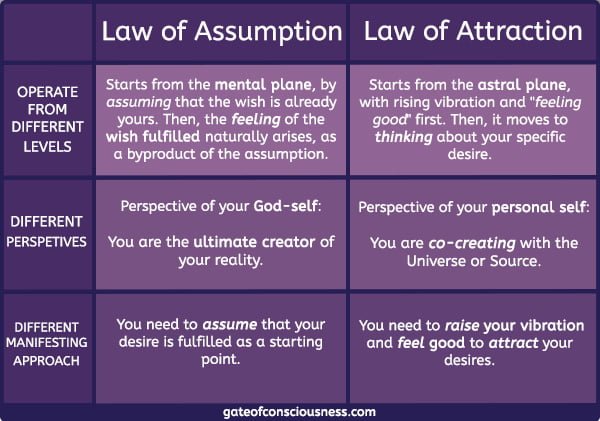Law of Assumption vs Law of Attraction: Which One Works Better?
Feeling frustrated by your inability to manifest what you truly desire? Perhaps you’ve been using the Law of Attraction, yet it’s just not working for you. As a manifestation coach, I’ve met countless people who struggle with the Law of Attraction. They’ve read “The Secret,” listened to Abraham Hicks, and tried every affirmation under the sun. Still, they don’t see the results they desire.
Today we’ll explain the key distinctions between the law of assumption and the law of attraction. We’ll also discuss how they affect your manifestation success. You’ll learn how to take your manifestation practice to the next level by understanding these fundamental principles.
Table of Contents:
What Are Universal Laws?
They are rules that govern how the Universe works. These laws are fundamental and unchanging.
Basically, they provide a framework for how reality operates. But, they are not based on science. We discovered them through empirical evidence, intuition, and introspection.
The term “universal law” can have different interpretations depending on the context.
Some people may consider only the 7 hermetic principles to be the true governing laws of the Universe. Others may define the term more broadly to encompass any metaphysical principle that explains how the Universe works.

The Law of Attraction
This is, without a doubt, the most well-known universal law in the manifestation community.
The law of attraction is a concept that dates back centuries. It can be traced back to ancient teachings, such as the Hindu Vedas, the teachings of Buddha, and Hermeticism. In modern times, the law of attraction became popularized by the New Thought movement in the late 19th century. Later on, in 2006, a book called “The Secret” brought the law of attraction into the mainstream.
Put simply:
The law of attraction states that like attracts like, hence the name.
Everything in the Universe, including us, is made up of energy and vibrations. Every thought and feeling we have also has its own vibrational frequency.
So the law of attraction works like a magnet that pulls in what you’re thinking and feeling. This includes ALL our thoughts and feeling and not just those we’re conscious of!
When we think and feel positive thoughts, we send out positive vibrations. And then these positive vibrations attract positive outcomes to us. Similarly, when we think and feel negative thoughts, we send out negative vibrations. So, we attract negative things to us.
The law of attraction is like tuning into a radio station. You have to tune your radio to the correct frequency to hear it clearly. Similarly, you must tune your vibrational frequency to the frequency of your desired outcome to attract it to you.
The idea is that you need to be mindful of the vibrations you’re putting out into the Universe. Especially if you want to attract positive things into your life.
The Law of Assumption
The law of assumption is a concept that was popularized by Neville Goddard. Goddard was a spiritual teacher and lecturer who lived in the 20th century. It also has its roots in ancient teachings and philosophies.
The law of assumption states that everything that exists in our external reality first existed as an assumption in our own minds.
We create our own reality through the assumptions we hold about ourselves, other people, and the world around us. So, everything we assume to be true must manifest.
The law of assumption about assuming the feeling and state of the reality you desire, as if it’s already here – like putting on a pair of glasses that allow you to see the reality you desire, and then acting as if it’s already true.
The law of assumption is a powerful tool to familiarize yourself with the state of your desire fulfilled.
Law of Assumption vs Law of Attraction: Key Differences
So what’s the difference between these 2 laws?
I’ll give you my take on the 3 key differences:
- They operate from different levels.
- They operate from different perspectives.
- They have different approaches to manifestation.

Next, will explain them in detail.
The Main Difference Between the Law of Assumption and the Law of Attraction
The first difference between them is that they operate from different levels of existence.
To explain this better, I have to introduce you to different levels of consciousness or reality. Every spiritual system has one. They all describe a hierarchical progression of consciousness or spiritual evolution. Each level builds upon the previous one.
For the sake of this post, we’ll only focus on the first three levels:
- Physical plane – a realm of our 3d reality, so no further explanation is needed.
- Astral plane – a realm of energy or consciousness that is more fluid and mutable than the physical world.
- Mental plane – a realm of pure thought, intellect, and consciousness, where the mind and its powers are paramount.
I know this might sound confusing, but bear with me:
The law of assumption involves assuming the state of the wish fulfilled in order to manifest it into physical reality.
This assumption takes place on the mental plane (also known as the Manomay Sharira in Hinduism). The mental plane is the level of consciousness where thoughts and ideas are formed, and it is believed to be a bridge between the physical and spiritual planes.
The law of attraction predominantly operates from the astral plane (Ling Sharira). The astral is one level below the mental plane. It’s the realm of emotions, desires, and dreams. It is where our emotions take form and attract corresponding experiences into our lives. Emotions are powerful energetic vibrations that can influence the reality we experience.
So, the law of attraction starts from the astral plane, with raising vibration and “feeling good” first. Then it moves to thinking about the specific desire one is trying to manifest.
As an example, Abraham Hicks always speaks about the importance of raising your vibration first, and then focusing on your specific desire. In a sense, the law of attraction takes a more gradual approach. We first raise our energy on the astral plane. Then we move up to the mental plane, by focusing more on the specific of our desire.
In contrast, the law of assumption starts from the mental plane, by assuming that the wish is already yours. Assuming demands good focus and mental effort. And then the feeling of the wish fulfilled naturally arises, as a byproduct of the assumption.
This is, in my opinion, the main difference between the two laws.
Second Difference: They Operate from Different Perspectives
The next difference between the law of assumption and the law of attraction involves your perspective of reality.
Let me explain:
The law of attraction is based on the idea that you are part of the Universe. So, it explains how reality works from the perspective of your personal self.
To manifest what you want, you must align your energy with your desire. Then the Universe delivers it to you. Basically, you are co-creating with the Universe or Source.
On the flip side, the law of assumption is based on the concept that you are the only reality. Nothing exists outside of you. In other words, the law of assumption works from the premise that you are God. It explains how reality works from the perspective of Godself. You are the ultimate creator of your reality.
Once again, we see the reverse approach between the two laws, just like in the first distinction. The law of attraction explains things progressing upward from the lower level. And the law of assumption works the other way around.
Third Difference Between Laws: Approach to Manifesting
This one should be obvious by now. The third difference between the two laws lies in their approach to manifesting.
According to the law of attraction, you need to raise your vibration and feel good to attract your desires. Yet, the law of assumption emphasizes assuming that your desire is fulfilled as a starting point to generate positive feelings and manifest one’s desires.
Assuming vs Attracting: Example
Let’s say you want to manifest a new job.
With the law of attraction, you would start by focusing on feeling good and raising your vibration. So you might meditate, listen to uplifting music, or do something else that brings you joy.
Once you are feeling good, you would then start to focus on the specifics of the job you want. For example, the type of work you want to do, the salary you want to earn, and so on. You might create a vision board or visualize yourself in the job to attract it.
Now let’s look at using the law of assumption to get the same job. The law of assumption teaches us that our desire is already real. So, instead of focusing on raising your vibration, you would assume that the job is already yours.
You might also start to live as if you already have the job. For instance, you can dress accordingly, assume the body language of a person who has that job, etc. You would maintain the assumption that the job is already yours, and allow the feeling of having the job to naturally arise as a byproduct of that assumption.
Which Works Better, the Law of Assumption or the Law of Attraction?
Neither. Even though their approaches are different, they actually both always work.
Let’s explain:
Once you successfully assume that your desire is already yours, you will naturally emit vibrations that are aligned with that desired outcome.
And vice versa:
Once you align your vibration with your desire, you will naturally start to believe that your desire is already yours.
In both cases, your desire will inevitably manifest in your life.
So, the better question to ask is:
What works better in your situation?
My general recommendation is to use the law of attraction in the following situations:
- If it worked for you repeatedly.
- If you understand and like the concept of it.
- If you are generally feeling pretty bad.
- If you are feeling a lot of resistance when focusing on your specific desire.
- If you have a lot of resistance toward the law of assumption.
- If you are completely new to manifesting.
Good reasons to try out the law of assumption:
- If you tried mainstream manifesting techniques and saw no result.
- If you find concepts such as energy and vibration too abstract or confusing.
- If you like the idea that you are the God of your reality.
- If your dominant state is positive, but you still can’t manifest your desires.
- If you are curious about it.
These are, of course, just some basic guidelines. Both approaches have their merits. Both involve working with our thoughts, and emotions on the subconscious level. It’s up to you to decide which one resonates with you more. Always test to find out what works best for you.
Testing approaches in real life
I want to share a recent example of one of my clients who was using the law of attraction for years with no result. She was struggling with finding a partner.
She had tried everything: self-love techniques, affirmations, raising her vibration, you name it. But it wasn’t until she started assuming the feeling of already being in a loving relationship that things started to shift. She started to feel loved, confident, and attractive, and before she knew it, she met her dream partner.
So in this particular case, the law of assumption helped her to familiarize herself with the feeling of being loved. Still, that doesn’t mean that it’s better! It has it’s own flaws too. For example:
The law of assumption can be hard to maintain when faced with contradictory evidence.
This example highlights the importance of experimenting with different techniques to find what works for you. You never know which approach or technique will help you manifest your desire!

Using the Law of Assumption vs Law of Attraction: Final Thoughts
Understanding these 2 laws can help you pick the right approach and techniques to manifest your desires. As you can see, they share similarities and describe the same principles from different angles.
Literally, everyone has the ability to use them. But the way they work varies. One person may find it easier to assume the state of their desire fulfilled, another to attract it.
As I said, you should try them both, especially if you want to have a bigger picture of how manifestation works. They complement each other, so experiment to find what works best for you.





